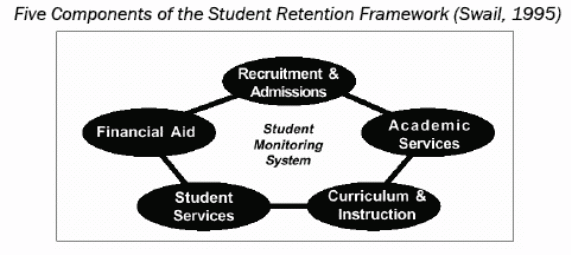Introduction
This is a handbook that aims to serve as a reference guide for “key stakeholders” regarding the realities and strategies and for student retention. This further aimed that other educational facilitator will learn a lot from this handbook, especially those who are responsible for making up complex decisions.
The basis of this handbook is this framework:

It is extremely important for the practitioners that they are aware of the relationship between each of the frameworks’ components and that they must understand its importance.
Component of this relationship with students
Financial aid is the first component of this relationship because it is a critical part of the students’ life. Students from low-income backgrounds are often under the ‘make-or-break’ category and they need financial assistance.
“A major barrier to access and persistence is the lack of information for parents and students regarding grants, loans, and scholarship opportunities. Colleges must be proactive in advising families of the price of college, selection criteria, and availability of financial aid opportunities” (Art of Student Retention, 2004)
Financial aid is divided into three different categories, which include:
- Information dissemination
- Enhancement of the availability of need-based assistance
- Reconsideration aid package
As for the second component which is recruitment and admission, it deals with the idea that the college is the “service university while the students are the clients”. The three categories under this second component involve student identification, admissions, and orientation. To promulgate such categories, the recruitment and admission segment has stated five major objectives:
- Having some pre-college programs or activities
- Providing alternatives to the existing assessment methods
- Having regular school visitations
- Initiating some on campus-living orientation programs
- Having freshmen orientation activities which is every first week of the school year
The third component is the academic services. Instead of student retention, the main focus of academic services is to provide auxiliary support to students aside from the normal practices done inside the classrooms. This component is divided into six categories:
- Academic advising
- Supplementary
- Instruction
- Tutoring and mentoring
- Research opportunities
- Pre-college programming
- Bridging programs
The fourth component, curriculum instruction, provides primary importance to “academic offices which should be the continuous process of curriculum review and revision”. It also highlights that every faculty member should practice teaching in an exciting, interesting, and motivating manner as this contributes to having the higher educational achievement of the students. This thus becomes a reflection of what the school can offer and what the teachers and other faculty members can do.
Student services are the fifth component. It should be noted that social integration with the institution is a factor for the students’ strength to persist.
“The role of the student services office has evolved to deal with many of the issues facing students on campus. The atmosphere and climate of the university, reflected by how the institution treats and supports students and by the positive nature of peer relations on campus, is important to the self-esteem and confidence a student generates” (Art of Student Retention, 2004).